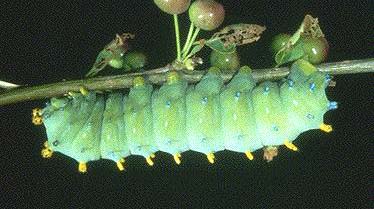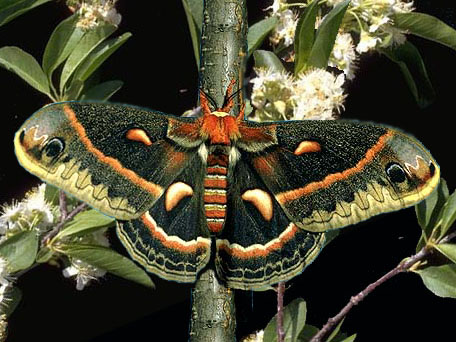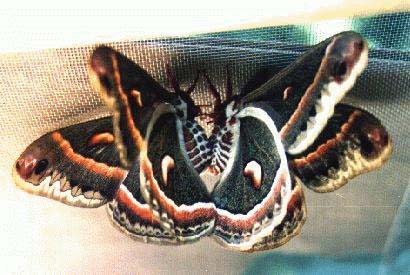indoor rearing of cecropia
HYALOPHORA CECROPIA: INDOOR REARING DISPLAYS AND GENERAL NOTES
Hyalophora cecropia larvae in their final
instar are spectacular for
both their tremendous size (approx. 11cm / 4.5in.) and beautiful
coloration. Many people come across these monsters feeding on
fruit trees in late summer.
Cocoons and ova are available for purchase. Click on
cocoons for a price list. | 
Photo
courtesy of University of kentucky |
Although the rearing of this species on open, indoor displays is labour
intensive, the majesty of these caterpillars makes the effort worthwhile.
Anyone interested in close observation of larvae, in protecting larvae
from
parasitization, or in introducing others to the fascinating world of
insects
should consider the option of indoor rearing.
The breeder, beginner or advanced, can begin with any of the four
metamorphic stages: 1) adult moths, 2) ova, 3) larvae, 4) cocoons.
In this article 1) sources for each metamorphic stage are explained,
2) an indoor rearing technique is described,
3) a general facts list is provided,
and 4) some suggestions are offered.
SOURCES
ADULT MOTHS:

Photo courtesy of Mike Soroka
Gravid females, distinguished from males by their much narrower
antennae and heavier bodies, are attracted to and easily captured at lights
in the early hours of darkness. Ultraviolet (black light) or mercury vapour
lamps radiating outward and upward in the vicinity of host food plants work
especially well from May-July, the flight time for this species. Biological
supply houses, individual dealers, or Home Lighting Centres are good sources
for these light fixtures. An old white bed sheet, secured vertically or
horizontally below the light, aids in the reflection of rays and also affords
the moths a resting place. A visiting moth can be hand picked or netted for
capture.
Virgin females, obtained from one's own reared or
purchased stock
or from cocoons found in the wild, mate readily in captivity. Some breeders
like to "tie out" or tether the females. One makes a half hitch loop near the
end of a soft cotton string, one to two feet (25-50cm) long, and slides this
loop over the female's abdomen up to the juncture with the thorax. The knot
is gently tightened and secured with a second half hitch. Working with a
partner facilitates this process. An assistant can hold the closed-winged
moth with its legs up and grasping a pencil while one slides the loop up to
its proper resting place. Once the female has been secured, she can be tied
out after dark by fastening the other end of the string to a small branch of a
tree. Males often do not arrive until after 4:00 am so "waiting up" is
impractical. One must, however, check the female before daybreak or the birds
will be chirping, "Thankyou, thankyou very much!" The couple should not be
separated, just protected from predation. Snipping the branch and bringing
the pair indoors is recommended. The moths will disengage before nightfall.
Cage matings require less work. The female is placed in a cage
with a mesh small enough to prevent her escape but large enough to allow
mating with a wild male. Square openings of at least 1/2 inch or 1.25 cm work
well. The cage, which need not be much over one cubic foot, should be checked
before day break. I fashion 14 inch high cylindrical cages out of 1/2 inch hardware
cloth and use a dinner plate for a lid over the 8.5 inch diameter top.
| This beautifully marked pair are
copulating inside a screen cage. The pair usually remain coupled for up to twenty
hours and separate naturally in the evening. The female will begin laying eggs
almost immediately so it is wise to keep an eye on her and move her to a bag as soon as pairing is over. |

Photo courtesy of Mike Soroka
|
OVA:
To obtain eggs, place the gravid female in an inflated brown
paper grocery bag. Fold down or twist close the top. Moving the female to a
new bag every day or two and keeping egg batches separate ensure the larvae
from each egg batch will emerge within a short hatching period. The used bag
is then cut into small patches around the ova and these slips are placed side
by side, egg side up, in a dry sandwich tray or small, wide-mouthed container.
Thirty to one-hundred eggs can be handled in a single tray. No food is placed
in the covered receptacle until the small black larvae are seen ten to twelve
days later. They usually eat a portion or all of their eggshells and sometimes
wander for a few hours before congregating on the food supplied after
emergence.
Ova can also be obtained from dealers. Postal shipment should
not be a problem as the eggs incubate for ten to twelve days at room
temperature. If the eggs arrive in a protective sleeve, i.e., aquarium
tubing, turkey quill, etc., they should be gently removed from the protection
and allowed to rest on the dry bottom of the hatching container.
Trying to find cecropia ova in the wild would be much like
looking for a needle in a haystack, but I have found them in groups of 4-5 on
the underside of elderberry leaves in areas of high cecropia populations
(Secaucus, New Jersey, 1960).
LARVAE:
Larvae generally are not shipped in the mail, but they can be
"picked up" from a breeder if you are close. It is not too difficult to find
wild caterpillars in areas of abundance. Since the larvae are voracious
eaters, missing foliage and droppings on the ground invite plant inspection by
collectors and predators. Unfortunately this species is highly susceptible
to parasitic wasps, especially in the fourth and fifth instars and high
percentages of "found" larvae are hopelessly parasitized. In such cases the
larvae grow and spin cocoons, but wasps are all that emerge the following
spring. Look on the underside of host plant leaves to find smaller, parasite
free larvae.
COCOONS:
Cecropia cocoons are huge compared to those of lunas, ios,
polyphemus, prometheas, etc. and they are usually affixed length wise to and
near the base of host shrubs or neighboring plants. These can be found before
or after leaf drop. Those that are spun up higher on the tree are quite
noticeable after leaf drop. Rats and mice also find them and feed on the
pupae. The cocoons are rugged and can be removed from stems by carefully
pulling from the top down. When the cocoons are attached to narrow/upper
stems, clipping is appropriate. The pupa is protected in a denser, inner
cocoon, considerably smaller than its looser, baggy, outer wrapping. A gentle
hefting and shaking can be used to determine the health of the pupa. A very
light rattling or no sound or movement at all indicates parasitization or
disease. A healthy pupa has a noticeable weight and will offer a dull thud
upon shaking.
Many dealers in North America offer cocoons
in the fall, winter,
or early spring. Cocoons may be winter-stored out doors in cages that would
protect them from predation by rats, racoons, skunks, etc., or they may be
kept in refrigerator crispers until the spring. Three to four weeks at room
temperature coupled with at least twelve hours of daylight/daily will often
trigger emergence.
The emergent moth exits the top of the cocoon and must find a
place to "hang" so fluid can be pumped into wing veins for expansion. An
emergence box with screening or cloth sides for climbing should be provided.
INDOOR DISPLAY REARING TECHNIQUE
In the fall of 1996 I had great
success with cecropia larvae which
proved to be quite sedentary and content
to remain near the tips of pin cherry
(Prunus pensylvanica) stems set up in
open, indoor displays. The displays
were used for educational purposes
in P.E.I. schools.
Five or six stems were inserted
through 1.5 centimeter diameter holes
in 2" x 8" spruce scraps which I
picked up for the asking at a nearby
construction site. The spruce was cut
into octagonal shapes and set to float
on seven centimeters of water in 11.4
litre ice cream buckets. The leafy
stems projected at least 30 cm above
the container tops.
A gravid female from a cage mating had been placed in a brown grocery bag
and fifty eggs laid on July 21-22 were moved, still affixed to paper, to a
three litre, wide mouthed, plastic candy jar. Larvae began emerging on the
morning of August 1. Two four-inch-long pin cherry stems with three to four
leaves attached to each were placed in the covered jar after the larvae
emerged. The caterpillars had all moved to the leaves and begun feeding by
evening. No coaxing was necessary.
To help keep the leaves fresh, I wrapped the cut end of each stem in moist
tissue and prevented a moisture build up in the candy jar by enclosing the
tissue wrap in a plastic sandwich bag, collapsed and secured with a twist tie.
I was also concerned with toxins possibly coming from the cut stems which were
allowed to lie flat on the bottom of the container. Pin cherry bark contains
some poisons. My concern, however, may have been unwarranted.
After three days of larvae growth, I removed the stems with caterpillars
attached to the indoor display previously described. The sanwich bag and
moist tissue were removed and the old stems were laid on top of and
perpendicular to the new food. The larvae soon moved to the fresh foliage.
Please note: My open displays were in a small 8' x 8' room where window and
door were kept shut. The evaporating moisture from the open buckets maintained a
humidity essential for caterpillar health. Indoor air is normally too dry for
such a display when caterpillars are small and would easily desicate. For the early stages,
it is best to use a closed container unless you can maintain a proper humidity.
As the larvae grew, their numbers were divided into smaller groupings
for each display. Food changes were accomplished by lifting all stems from
the spruce support, laying the old stems on a newspaper covered, flat surface,
raising and rinsing the spruce, dumping the old water, rinsing the container,
adding fresh water, replacing the spruce, inserting fresh stems and finally
transferring the old stems with caterpillars to the new displays.
The old stems were carefully laid across the tops of or inserted
vertically among the new stems. Care was taken to avoid transfers during
molting, but occasionally one or two caterpillars would be slightly ahead of
or behind their peers. Quiescent caterpillars were moved as carefully as
possible and none were lost due to molting or any other problems. Old stems
were lifted and discarded once the larvae had moved.
Food stayed fresh for six-seven days and was replaced as leaves were
depleted. Larvae spent approximately one week in each instar except for
the fifth instar which lasted slightly more than two weeks. Food had to be
replaced more regularly as the larvae grew. During the final instar, food
was being replaced every two to three days to stay ahead of 5-6 larvae on
each display. Indoor temperatures stayed fairly constant, between 68 and 75
degrees F.
Fresh food was always selected from lush plants. The cut stem ends went
immediately into water to avoid any wilting. To cut down on repeated food
hunts, I gathered more than needed and kept the food fresh by placing it
outside in a shady location with cut ends immersed in a few inches of water.
No special provisions were made for the spinning of cocoons. Some of the
larvae spun at the base of the stems just above the spruce float, but many
spun up in the leaves above the container rim. I let the larvae have at least
two weeks in the cocoon before moving them into cold storage. Cooling before
pupation occurs may destroy all your efforts.
A big surprise was that no larvae attempted to leave the uncovered
buckets. They rarely descended below the bucket rims except to spin cocoons.
It is reported that the larvae of the domesticated bombyx mori have been so
conditioned by the constant human provision of fresh food that they will
starve themselves rather than crawl any distance for fresh leaves. Perhaps
the cecropia larvae, which never had to move far for food, were also
responding to a bit of conditioning.
Another sampling of larvae from the same ova group (July 21-22) was
raised outdoors in a large, vertical sleeve until September 6. These larvae
still had ample food in their enclosure when I brought them in, but all the
upper most leaves had been eaten and the caterpillars had done quite a bit of
walking down branches and the trunk to access foliage on lower branches.
When these caterpillars were brought indoors and set up on the dispays,
the larvae continued walking, frequently crawling down the stems and up and
over the sides of the containers. I had to cover all these set-ups with
inverted buckets for containment. Side by side on a newspaper-covered plastic
floor mat were open displays of sedentary cecropia and covered buckets of
discontented crawlers.
Several displays of the sedentary group were taken into schools and left
uncovered. Fascinated students gently stroked the larvae with their fingers.
The unobstructed viewing of the tireless spinning was also a special treat.
None of the larvae wandered.
Teachers or breeders who supply schools, may want make use of this
technique. A word of caution, however: Make sure you advise the custodian
as to what is lurking in the attractive greenery on the teacher's desk.
HYALOPHORA CECROPIA: GENERAL FACTS
COMMON NAMES: Cecropia, Robin moth
RANGE: Eastern North America to the Rockies, Canada to the deep south
SIZE: This is North America's largest saturniidae with a 5-6 inch
(13-15 cm) wingspan. Caterpillars achieve lengths exceeding
4 inches (10 cm)
LARVAE:
FIRST INSTAR: black with black dorsal and lateral tubercles
SECOND : yellow-green with black tubercles
THIRD : green with four red thoracic tubercles,
yellow dorsal and blue lateral tubercles
FOURTH : identical to third
FIFTH : green with four red-orange thoracic tubercles, yellow
dorsal and blue lateral tubercles, a gray oval
surounding each spiracle
COCOON: Cocoons are of two types:
1) a large, loose, baggy structure,
with a rounded bottom and a tapered neck;
2) a smaller, denser
oblong structure with a tapered neck and bottom. In either
case there is an oblong, inner cocoon of relatively tight
construction. Cocoons are always affixed longitudinally to
a stem and are generally red-brown or brown, although some are
gray or even a drab green. Compared to cocoons of other North
American species, these are monsters, up to 4 inches (10 cm)
long and 2 inches (5-6cm) wide.
FLIGHT TIMES: May to July, primarily in June. In southern states cecropia
have flights recorded from late April to early August.
LIFE SPAN: One year. This species is single brooded and spends the vast
majority of the year in the cocoon/pupa stage.
Adult life: six to eight days
Egg Incubation: ten to fourteen days
Larval Development: five to eight weeks
FOOD PLANTS: Cecropia accept a wide range of food plants, many of which
transport and hold water very well: pin cherry, choke cherry
and other Prunus species; Manitoba maple or box elder; willow;
apple; lilac, pecan in the south, elderberry, American elm,
green ash, southern bayberry or wax myrtle, red maple, poplar,
Amelanchier, Crataegus, and Viburnum species.
TREE DAMAGE: Generally not regarded as a pest, but in high population
densities will defoliate smaller shrubs, i.e., Manitoba maples
in the prairie provinces. Females generally lay a single row
of four to five eggs on the underside of a leaf.
REARING: Fresh or cut food is accepted. Avoid overcrowding and protect
from parasitization. A clean sleeve or cage will minimize risk
of disease. Warmth seems to stimulate growth, but avoid
overheating.
DEMAND: Popular in Europe and North America. Research regarding
distribution diversity, food plant influence on coloration,
pheromone analysis, intergrades with other species of
Hyalophora, etc., tends to go on at various universities and in
private studies. More zoos are setting up live insect displays.
Life histories and art displays create demands. Schools seek
life histories and live displays for educational purposes.
Excellent in salads. I hope not!


